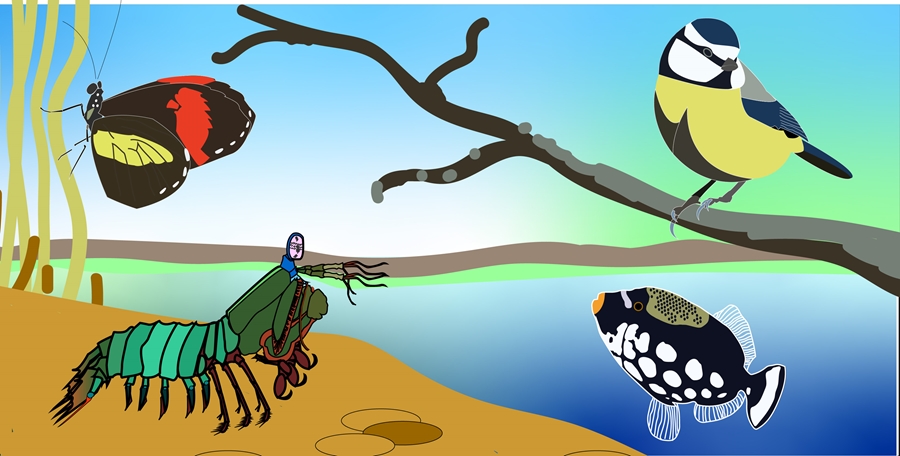New Study Deepens Understanding of How Animals See, and What Colors

Researchers determined that animals adapted to land see more colors than animals adapted to water. Animals adapted to open terrestrial habitats see a wider range of colors than animals adapted to forests.
Gathering vision data for hundreds of vertebrates and invertebrates, U of A biologists have deepened scientists’ understanding of animal vision, including the colors they see.
Those researchers have determined that animals adapted to land are able to see more colors than animals adapted to water. Animals adapted to open terrestrial habitats see a wider range of colors than animals adapted to forests.
However, evolutionary history — primarily the difference between vertebrates and invertebrates — significantly influences which colors a species sees. Invertebrates see more short wavelengths of light, compared to vertebrates.
Biological sciences doctoral student Matt Murphy and assistant professor Erica Westerman recently published these findings in Proceedings of the Royal Society B, a top British scientific journal. Their article, “Evolutionary history limits species’ ability to match colour sensitivity to available habitat light,” explains how environment, evolution and, to some extent, genetic composition influence how and what colors animals see.
“Scientists have long hypothesized that animal vision has evolved to match the colors of light present in their environments,” Westerman said. “But this hypothesis is difficult to prove, and there is still so much we don’t know about animal vision. Gathering data for hundreds of species of animals living in a wide range of habitats is a monumental task, especially when considering that invertebrates and vertebrates use different kinds of cells in their eyes to turn light energy into neuronal responses.”
 |
| Matt Murphy and Erica Westerman |
An animal's ability to detect visual information depends on the wavelengths and intensity of light in a given environment. Quantity and wavelength sensitivity of a family of retinal proteins, called opsins, govern the spectrum of light an animal sees — from ultraviolet to far red light.
However, invertebrates and vertebrates use phylogenetically distinct opsins in their retinae, and researchers have not determined whether these distinct opsins influence what animals see or how they adapt to their light environments.
Murphy and Westerman collated vision data for 446 species of animals spanning four phyla. One of these phyla contained vertebrates — animals that have backbones, such as fish and humans. The rest of these phyla contained animals that were invertebrates - those that do not have backbones, such as insects, squid and jellyfish.
The researchers’ study showed that while animals do adapt to environments, their ability to adapt can be physiologically constrained. While vertebrates and invertebrates broadly use the same cell type, opsins, to see, they build these cells differently. This physiological difference — what biologists call ciliary opsins in vertebrates and rhabdomeric opsins in invertebrates — might explain why invertebrates are better at seeing short wavelength light, even when habitat should select for vertebrates to also see short wavelengths of light.
However, the difference could be due to stochastic genetic mutations occurring in vertebrates but not invertebrates, Westerman said. These mutations could also limit the range of light in vertebrates’ vision.
“Our study answers some important questions,” Murphy said, “but it also generates more questions that could help us understand animal vision even better. We can do more to assess differences in the structure of the vertebrate and invertebrate retinae, or how their brains handle visual information differently. These are exciting questions.”
About the University of Arkansas: As Arkansas' flagship institution, the U of A provides an internationally competitive education in more than 200 academic programs. Founded in 1871, the U of A contributes more than $2.2 billion to Arkansas’ economy through the teaching of new knowledge and skills, entrepreneurship and job development, discovery through research and creative activity while also providing training for professional disciplines. The Carnegie Foundation classifies the U of A among the few U.S. colleges and universities with the highest level of research activity. U.S. News & World Report ranks the U of A among the top public universities in the nation. See how the U of A works to build a better world at Arkansas Research News.
Topics
Contacts
Erica Westerman, assistant professor of biological sciences
Fulbright College of Arts and Sciences
479-575-5348,
ewesterm@uark.edu
Matt Murphy, doctoral student of biological sciences
Fulbright College of Arts and Sciences
479-575-5348,
mjm052@uark.edu
Matt McGowan, science and research communications officer
University Relations
479-575-4246,
dmcgowa@uark.edu
Headlines
PetSmart CEO J.K. Symancyk to Speak at Walton College Commencement
J.K. Symancyk is an alumnus of the Sam M. Walton College of Business and serves on the Dean’s Executive Advisory Board.
Faulkner Center, Arkansas PBS Partner to Screen Documentary 'Gospel'
The Faulkner Performing Arts Center will host a screening of Gospel, a documentary exploring the origin of Black spirituality through sermon and song, in partnership with Arkansas PBS at 7:30 p.m. Thursday, May 2.
UAPD Officers Mills and Edwards Honored With New Roles
Veterans of the U of A Police Department, Matt Mills has been promoted to assistant chief, and Crandall Edwards has been promoted to administrative captain.
Community Design Center's Greenway Urbanism Project Wins LIV Hospitality Design Award
"Greenway Urbanism" is one of six urban strategies proposed under the Framework Plan for Cherokee Village, a project that received funding through an Our Town grant from the National Endowment for the Arts.
Spring Bike Drive Refurbishes Old Bikes for New Students
All donated bikes will be given to Pedal It Forward, a local nonprofit that will refurbish your bike and return it to the U of A campus to be gifted to a student in need. Hundreds of students have already benefited.




